
cattle guard and elaborate stone entrance -- TxDOT
Functional or fancy, wood or metal, gates have been a part of the rural landscape for nearly as long as settlers have been settling the land. While the materials and designs vary from region to region, gates share a common duty: to keep animals in and trespassers out.

"Fencing has played an essential part in the transformation of wild landscapes into cultural landscapes on the American prairie," wrote geographers Leslie Hewes and Christian Jung, who studied early fencing in the Midwest. "In some cases, enclosures of farms and fields are sufficiently conspicuous or distinctive to help give character to a place."
Indeed, today's landowner can choose from an array of gate designs, each reflecting the owners' style, farm or ranch operation and personal interests. Their ancestors, on the other hand, were limited to using the products readily available and designs that would be sturdy yet quick to build.
Early Southern Gates: Longleaf Pine
Retired Mississippi farmer and agricultural historian George Heindl says before the advent of sawmills, southern farmers relied on longleaf pine prevalent in that region in the mid- to late-1800s to build split-rail fencing and gates. "The longleaf pine had a lot of resin in it, which made it a strong wood. It grew slowly in diameter, so that year after year the sap was being pumped into the tree, causing a tremendous amount of hormones from the roots going up into the tree," he says.
A typical 1860s gate was built by splitting longleaf pine into posts approximately five inches in diameter, and sharpening one end of the post to a two-inch point. The farmer would cut a block of wood from the pine tree, bury it two feet under ground and drive the pointed end of the post into the block to secure it. A hole was chiseled into the upper end of the split rail, through which the farmer could slip an iron from the hub of a buggy, thus creating the swinging end of the gate.
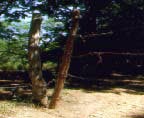
cedar gap
- TxDOT
Milled Lumber: A Costly Alternative
Despite the post-Civil War emergence of lumber mills, many southern farmers continued to construct their gates the old-fashioned way. "In the South, lumber mills were few and far between," says Heindl. "It could be a 30-mile trip to a mill, and take a day to get there."
Furthermore, the price of milled lumber was high. "You could buy a wagonload for $6, which was a lot when a good day's work would earn you only 35 cents," says Heindl, who helped build the Mississippi Agricultural Museum, located in Jackson. For the last 17 years, he has led tours at the museum, where he says visitors now can see examples of the longleaf pine-and-wagon wheel hub gates.
Cedar Saddle Gaps In Texas
In Central Texas, farmers were equally resourceful. "The first gates in this area were pole gates, using a cedar post," remembers Elroy Brown, an interpreter at Jourdan-Bachman Pioneer Farm near Austin. "We would set the gate on a rock with one ring at the bottom and one ring at the top. You'd have another round hook or chain to shut the gate." Gaps, or saddle gaps, also were popular. Typically built just wide enough to ride a horse through, the gap would have a cedar post at each end, with two to three smaller gap posts in between. "You'd put your wire on it, stick them up and make a hook out of wire at the top and bottom," Brown recalls. Because they were quick and simple to build, saddle gaps often were preferred over more elaborate gates. Today, saddle gaps still can be spotted along back roads in Central and West Texas.
Cedar Saddle Gaps In Texas
In Central Texas, farmers were equally resourceful. "The first gates in this area were pole gates, using a cedar post," remembers Elroy Brown, an interpreter at Jourdan-Bachman Pioneer Farm near Austin. "We would set the gate on a rock with one ring at the bottom and one ring at the top. You'd have another round hook or chain to shut the gate." Gaps, or saddle gaps, also were popular. Typically built just wide enough to ride a horse through, the gap would have a cedar post at each end, with two to three smaller gap posts in between. "You'd put your wire on it, stick them up and make a hook out of wire at the top and bottom," Brown recalls. Because they were quick and simple to build, saddle gaps often were preferred over more elaborate gates. Today, saddle gaps still can be spotted along back roads in Central and West Texas.
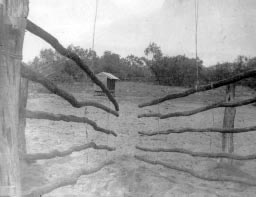
trigger gate
- Courtesy King Ranch Archives, King Ranch, Inc., Kingsville Texas
Gaps: A Speedier, Cheaper Alternative
Although most riders still had to get off their horses to open the gap, Brown found a solution that kept him in the saddle. "I had an old mule who would push up that gap pole. I'd tell her to go round up the cows, and she'd let all the cows out for me," he says. "You know, mules are a lot smarter than horses."
Longtime rancher Joe Dan Weedon might argue that point. On his 2,300-acre ranch at Brownwood, Texas, Weedon remembers the days when his dad's horse would go through the saddle gap and round up the cows. "My dad never had to get off his horse," he laughs. It seems you can teach an old horse new tricks, sometimes.
Weedon, who served for many years as a director of the Federal Land Bank Association of Brownwood, says until the 1860s, people ranched on the free range where fences, and thus gates, were nonexistent. Over time, however, cattlemen began fencing in water holes for their herds.
On a ranch the size of Weedon's, cross fencing necessitated as many as 50 gates. In Central Texas, ranchers used small split-rail cedar posts because of their durability. Whereas a saddle gap could be constructed in less than an hour, a typical cedar split-rail gate could take several hours to complete. Even so, for most working ranchers, a split-rail gate was more economical than one built of lumber purchased from a mill 100 miles away.
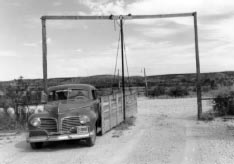
bump or bumper gate -- TxDOT
Cattle Guards: Effective But Hazardous
Many ranchers bypassed building gates altogether, opting instead for cattle guards - known also as "Texas gates" to northern farmers. Building a cattle guard simply required digging a small hole, pouring a slab on either side, and putting a pipe or several pipes across the opening with gaps between them. The trick was to make the gaps just wide enough so a cow could see the hole below and be deterred from crossing, yet not so wide a calf could step through and get a leg caught between the pipes, says retired King Ranch foreman Leonard Stiles. Because of the dangers of cattle getting their legs caught and broken between the pipes, cattle guards were rarely used on "the King."
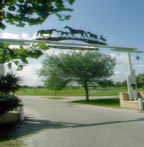
iron gate art
For Convenience: Bumper Gates
Sheep and goat raisers did not use them, either. "A cattle guard won't turn a sheep or goat," says Weedon. Thus, a common alternative was, and is, a bumper gate.
"You'd have a straight line fence and a real long gate. In the middle of the gate would be a tall pole with a twist and a half of heavy wire cable wrapped around it," says Herbert Loeffler, Brownwood branch president of the FLBA of Texas. "The rancher would push his truck bumper to the end of the gate, causing it to swing open enough for the pickup to pass through before swinging shut again. The gates are heavy enough so the wind won't blow them open," he says.
On the King Ranch, Stiles dubbed bumper gates "ladies' gates," because they saved the person riding shotgun in the truck cab - usually the rancher's wife - from having to get out of the pickup to open the gate.
Today's Gates: Steel, Elaborate, Sturdy
Nowadays, the elite of gates might be one with solar-powered remote control, perfect for the remote ranch that does not have access to electricity. Or it might be a metal gate displaying the ranch brand. "Today you can still register a brand at the courthouse, so even newcomers to ranching are doing it," says Weedon.

horseshoe arch -- TxDOT
In Lometa, Texas, where William DuBose has been crafting farm and ranch fencing and gates for 25 years, steel piping is the preferred material due to its durability and affordability. DuBose and his father began using piping in the mid-1970s, when lumber prices skyrocketed. Today, a linear foot of DuBose fencing costs $2.75. Built of lumber, the same fence would cost two to three times more.
The firm also takes custom gate orders, mostly for fancy wrought iron-type gates with ranch art at the top. For these, prices are in the $1,500 to $3,000 range. Fancy gates aside, DuBose says the gate-building business has not changed much in 30 years. "It was done then exactly the same way we do it now. Prices haven't changed much either. It's just that we used to make a good income; now we get by," he quips.
While DuBose is seeing more interest in elaborate iron gate art, up the road in Hico, Texas, Bobby Kerr, a one-time sign painter and champion cutting horse trainer, has built a thriving business from the popularity in ranch gate art. What began nine years ago in a rented shop with a newly purchased torch and some metal has grown into a business employing him and three others, who build gates, western furniture and, of late, western painted tiles.
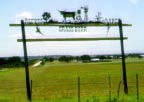
iron "ranch art" -- TxDOT
The popularity of his work was immediate. "We stay six to eight months behind (in filling orders), and it's been that way since the first month we were in business," he says.
While most of Kerr's clients are within 200 miles of Hico, he has built wrought iron gates for people across the country. "Our customers are a bit of both the working ranchers as well as a lot of weekend ranchers," notes Kerr, who draws much business from white collar workers from the Dallas/Fort Worth Metroplex who have purchased recreational property or who commute to work from their country getaways.
All of Kerr's designs feature metal cutouts of ranch scenes, wildlife or ranch brands. A typical gate is 24 to 26 feet wide, 12 to 14 feet tall, and costs $50 per square foot.
Regardless of the design and materials used, gates likely will remain part of the rural landscape and architecture as the countryside becomes more populated. As one old-timer put it, "Gates are built not so much to keep the animals in, as to keep people out."
-Sue Durio